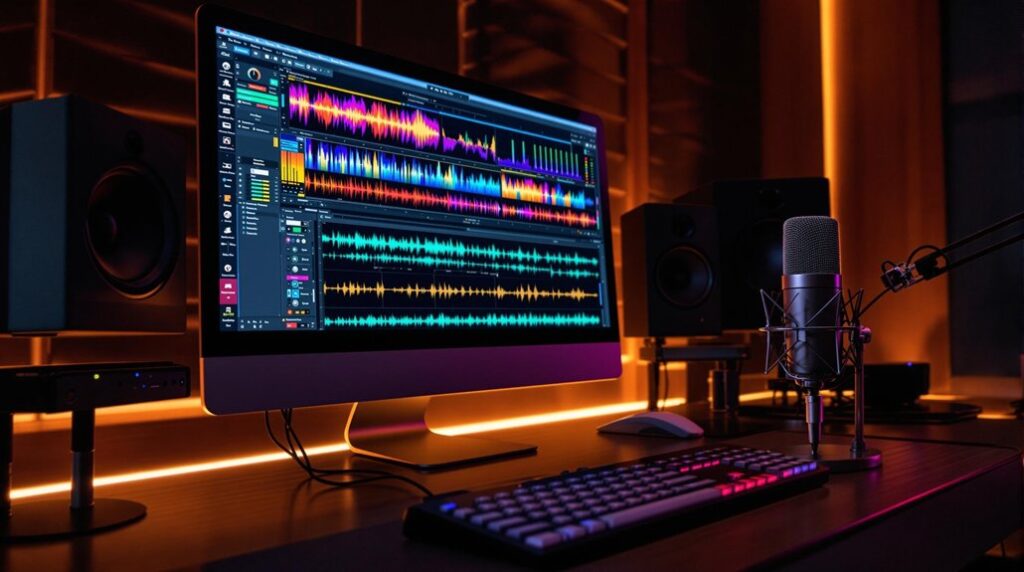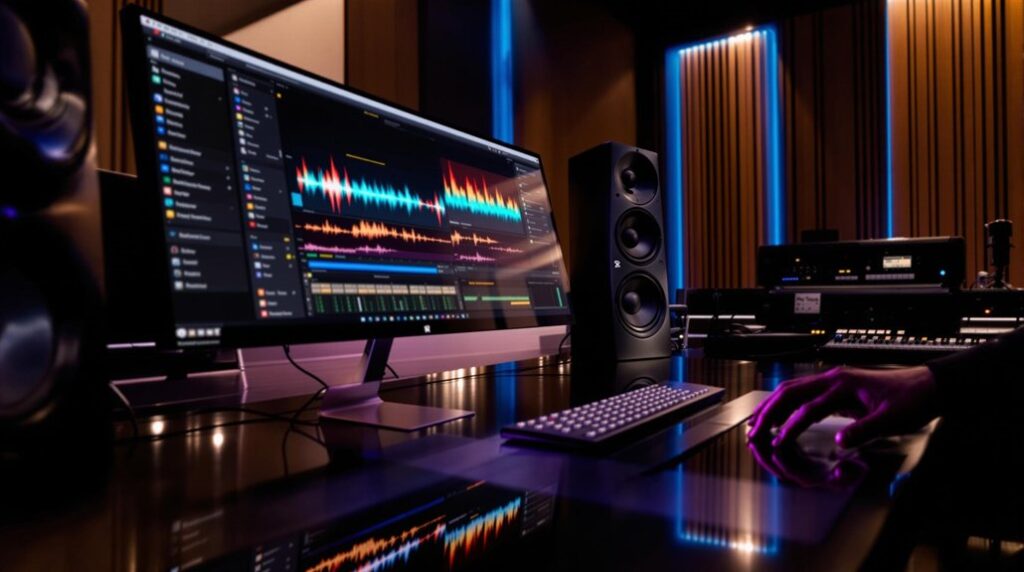Mastering the Pro Tools nudge shortcut involves a structured approach in five key steps. Begin by understanding and selecting appropriate nudge values through the dropdown menu to dictate precise audio shifts. Configure these settings by customizing the nudge increments for intended precision, ideally setting to one frame for fine-tuning. Utilize keyboard shortcuts effectively, with the minus and plus keys for general nudging and comma/full stop keys for frame-by-frame adjustments. Modify nudge increments via the Nudge Value menu and set your counter to a timecode for accuracy. Finally, apply nudges efficiently by ensuring correct track selection and input levels. Explore further for thorough mastery.
Key Takeaways
- Familiarize yourself with the default nudge values like bars, beats, seconds, and frames for precise audio adjustments.
- Use keyboard shortcuts: minus and comma keys to nudge backward; plus and full stop keys to nudge forward.
- Customize nudge increments through the Nudge Value menu for precise control over audio clip movements.
- Set the counter to time code for accurate nudge visibility and efficient navigation of audio tracks.
- Join online communities to learn and share new methods and shortcuts for effective audio editing in Pro Tools.
Grasping Nudge Values
Understanding nudge values in Pro Tools is essential for achieving precise audio editing. Nudge values dictate the exact increment by which audio clips are shifted within a Pro Tools session. The default settings often include bars, beats, or time-based measurements like seconds and frames. For detailed adjustments, setting the nudge value to one frame is recommended, enhancing precision considerably. Adjusting these values efficiently requires familiarity with the nudge value dropdown menu, allowing users to select increments for larger movements, such as six frames or one second. Counter settings, particularly time code, are vital for maintaining clear frame visibility when nudging. Regularly altering nudge values can optimize editing efficiency, enabling users to fine-tune or make swift adjustments as the Pro Tools session demands. Mastering both Grid and Slip Modes is crucial for effective audio editing, as it provides the flexibility needed for precise and creative edits.
Configuring Nudge Settings
Configuring nudge settings in Pro Tools is an essential step in refining your audio editing workflow.
Begin by accessing the nudge value menu at the top of the screen, where you can customize the movement of audio clips by selecting increments such as bars, beats, minutes, seconds, or samples.
For ideal precision, make sure that your counter settings are set to time code, enhancing the visibility of nudge values.
Adjust the nudge value to meet your project's specific needs, with a default recommendation of one frame for fine adjustments. Larger increments like six frames or one second can facilitate quicker edits.
Utilize the nudge pop-up menu to tailor these settings, enabling efficient modifications, thereby streamlining your workflow across diverse audio tracks and sessions.
For optimal results, ensure that your signal flow is properly organized to maintain audio clarity and prevent any potential mix issues during editing.
Utilizing Keyboard Shortcuts
Mastering keyboard shortcuts in Pro Tools is essential for optimizing your audio editing efficiency. Utilizing the numeric keypad in Pro Tools, you can nudge clips backward by pressing the minus key and forward by pressing the plus key. For precise timing adjustments, use the comma key to nudge backward by one frame and the full stop key for forward movement. The M and forward slash keys temporarily override the nudge values, providing flexibility when using Pro Tools for intricate edits. Customizing nudge increments through the dropdown menu allows for adjustments tailored to your specific editing requirements, whether you need broader movements or finer precision. Engaging with online groups focused on specific Pro Tools facets fosters shortcut sharing and uncovers new methods for tailoring Pro Tools to individual needs.
Modifying Nudge Increments
Building on the efficiency gained through keyboard shortcuts, adjusting nudge increments in Pro Tools is a critical step for tailoring your audio editing process to specific project needs.
Nudge increments can be customized via the Nudge Value menu, offering precise control over audio clip placement. For meticulous adjustments, set the nudge value to one frame, utilizing the numeric keypad to navigate accurately.
For broader edits, increase the nudge value to six frames or one second, optimizing workflow speed. Make certain the counter is set to time code for precise nudge visibility.
Efficiently modify nudge values using the dropdown menu, adapting to project requirements. The MIDI editor in Pro Tools offers additional capabilities for fine-tuning timing and dynamics when working with MIDI data. This customization enhances your editing precision, allowing seamless shifts between detailed and broader adjustments.
Applying Nudges Effectively
When applying nudges effectively in Pro Tools, it is vital to first confirm that your nudge value is appropriately set via the nudge pop-up menu, as this determines the exact increment by which audio clips will be moved. This foundational step is significant for precision editing. Utilize the numeric keypad shortcuts, specifically the minus keys, to nudge clips backward and the plus keys to move them forward. For more granular adjustments, use the comma and full stop keys to move clips frame-by-frame. Always verify the correct track is selected and nudge settings are accurate, as missteps can obstruct workflow efficiency. Remember to maintain input levels under ideal levels to prevent digital clipping during your Pro Tools sessions.
'''markdown
| Action | Key Used | Nudge Direction |
|---|---|---|
| Move Backward | Minus Key | Backward |
| Move Forward | Plus Key | Forward |
| Frame-by-frame Back | Comma Key | Backward |
| Frame-by-frame Fwd | Full Stop | Forward |
| Adjust Nudge Value | Pop-up Menu | N/A |
'''
Frequently Asked Questions
How to Nudge in Pro Tools Shortcut?
To nudge in Pro Tools using shortcuts, set nudge values in the nudge settings menu. Utilize numeric keypad shortcuts for forward or backward movement. For precise adjustments, temporarily override nudge values by using specific keyboard keys for quick modifications.
What Are the Quick Keys for Nudging up Down Clip Gain?
The quick keys for nudging clip gain in Pro Tools utilize the nudge commands: "Control + Shift + Up Arrow" to incrementally increase clip gain and "Control + Shift + Down Arrow" to decrease it, enabling precise audio level adjustments.
What Is the Shortcut for Master Fader in Pro Tools?
The shortcut for accessing the Master Fader in Pro Tools involves holding the "Command" (Mac) or "Control" (Windows) key while pressing "Shift" and "N." This facilitates track adjustments by providing extensive control over session audio levels.
What Does Shift S Do in Pro Tools?
In Pro Tools, the Shift S function serves as a shortcut to solo the selected track(s), facilitating the isolation of audio elements. This Pro Tools shortcut enhances workflow efficiency by allowing precise track monitoring during mixing or editing.
Conclusion
The effective utilization of Pro Tools' nudge functionality hinges on a thorough understanding of nudge values and the meticulous configuration of settings, alongside mastery of keyboard shortcuts. By modifying nudge increments to suit specific project requirements, precision in audio editing is greatly enhanced. The strategic application of these nudges facilitates seamless manipulation of audio clips, ensuring ideal alignment and synchronization. This systematic approach renders the nudge tool an indispensable asset in achieving professional-grade audio production outcomes.




